Small bowel MR enterography: problem solving in Crohn's disease
- PMID: 22696087
- PMCID: PMC3369125
- DOI: 10.1007/s13244-012-0154-3
Small bowel MR enterography: problem solving in Crohn's disease
Abstract
Magnetic resonance enterography (MRE) is fast becoming the first-line radiological investigation to evaluate the small bowel in patients with Crohn's disease. It can demonstrate both mural and extramural complications. The lack of ionizing radiation, together with high-contrast resolution, multiplanar capability and cine-imaging make it an attractive imaging modality in such patients who need prolonged follow-up. A key question in the management of such patients is the assessment of disease activity. Clinical indices, endoscopic and histological findings have traditionally been used as surrogate markers but all have limitations. MRE can help address this question. The purpose of this pictorial review is to (1) detail the MRE protocol used at our institution; (2) describe the rationale for the MR sequences used and their limitations; (3) compare MRE with other small bowel imaging techniques; (4) discuss how MRE can help distinguish between inflammatory, stricturing and penetrating disease, and thus facilitate management of this difficult condition. Main Messages • MR enterography (MRE) is the preferred imaging investigation to assess Crohn's disease. T2-weighted, post-contrast and diffusion-weighted imaging (DWI) can be used. • MRE offers no radiation exposure, high-contrast resolution, multiplanar ability and cine imaging. • MRE can help define disease activity, a key question in the management of Crohn's disease. • MRE can help distinguish between inflammatory, stricturing and penetrating disease. • MRE can demonstrate both mural and extramural complications.
Figures
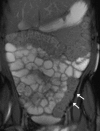
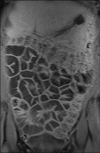

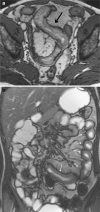

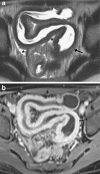
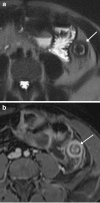
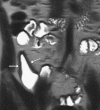
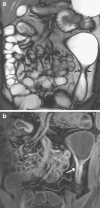

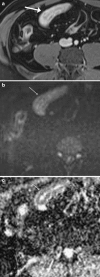





Similar articles
-
Performance of Surveillance MR Enterography (MRE) in Asymptomatic Children and Adolescents With Crohn's Disease.J Magn Reson Imaging. 2019 Dec;50(6):1955-1963. doi: 10.1002/jmri.26811. Epub 2019 May 30. J Magn Reson Imaging. 2019. PMID: 31145502
-
Preoperative evaluation of small bowel complications in Crohn's disease: comparison of diffusion-weighted and contrast-enhanced MR imaging.Eur Radiol. 2019 Apr;29(4):2034-2044. doi: 10.1007/s00330-018-5734-2. Epub 2018 Oct 9. Eur Radiol. 2019. PMID: 30302591
-
MR enterography in Crohns disease and beyond: a pictorial review : Beyond Crohn's: a pictorial guide to MR enterography in small bowel disease.Abdom Radiol (NY). 2025 Feb 3. doi: 10.1007/s00261-025-04824-z. Online ahead of print. Abdom Radiol (NY). 2025. PMID: 39899083 Review.
-
Utility of the diffusion-weighted imaging for activity evaluation in Crohn's disease patients underwent magnetic resonance enterography.BMC Gastroenterol. 2015 Feb 5;15:12. doi: 10.1186/s12876-015-0235-0. BMC Gastroenterol. 2015. PMID: 25653007 Free PMC article.
-
Pediatric Magnetic Resonance Enterography: Focused on Crohn's Disease.Pediatr Gastroenterol Hepatol Nutr. 2015 Sep;18(3):149-59. doi: 10.5223/pghn.2015.18.3.149. Epub 2015 Sep 25. Pediatr Gastroenterol Hepatol Nutr. 2015. PMID: 26473134 Free PMC article. Review.
Cited by
-
Current tecniques and new perpectives research of magnetic resonance enterography in pediatric Crohn's disease.World J Radiol. 2016 Jul 28;8(7):668-82. doi: 10.4329/wjr.v8.i7.668. World J Radiol. 2016. PMID: 27551337 Free PMC article. Review.
-
Diagnostic Value of Diffusion-Weighted Imaging and Apparent Diffusion Coefficient in Assessment of the Activity of Crohn Disease: 1.5 or 3 T.J Comput Assist Tomogr. 2018 Sep/Oct;42(5):688-696. doi: 10.1097/RCT.0000000000000754. J Comput Assist Tomogr. 2018. PMID: 29958199 Free PMC article.
-
Quantitative Magnetic Resonance Imaging (qMRI) of the Small Bowel in Crohn's Disease: State-of-the-Art and Future Directions.J Magn Reson Imaging. 2025 Mar;61(3):1048-1066. doi: 10.1002/jmri.29511. Epub 2024 Jul 6. J Magn Reson Imaging. 2025. PMID: 38970359 Free PMC article. Review.
-
Patient optimization for surgery relating to Crohn's disease.Nat Rev Gastroenterol Hepatol. 2016 Dec;13(12):707-719. doi: 10.1038/nrgastro.2016.158. Epub 2016 Oct 26. Nat Rev Gastroenterol Hepatol. 2016. PMID: 27780971 Review.
-
Positioning intestinal ultrasound in a UK tertiary centre: significant estimated clinical role and cost savings.Frontline Gastroenterol. 2022 Jul 8;14(1):52-58. doi: 10.1136/flgastro-2022-102156. eCollection 2023. Frontline Gastroenterol. 2022. PMID: 36561789 Free PMC article.
References
-
- Assche G, Dignass A, Panes J, Beaugerie L, Karagiannis J, Allez M, Ochsenkühn T, Orchard T, Rogler G, Louis E, Kupcinskas L, Mantzaris G, Travis S, Stange E, European Crohn’s and Colitis Organisation (ECCO) The second European evidence-based Consensus on the diagnosis and management of Crohn’s disease: Definitions and diagnosis. J Crohns Colitis. 2010;4:7–27. doi: 10.1016/j.crohns.2009.12.003. - DOI - PubMed
LinkOut - more resources
Full Text Sources
Other Literature Sources

